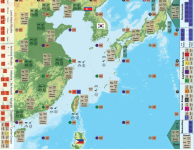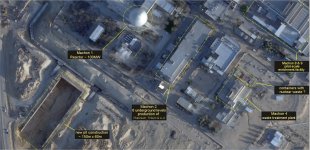Wargaming a Chinese Invasion of Taiwan
CSIS wargamed a Chinese invasion of Taiwan 24 times and found that Taiwan would endure as a democratic and independent entity in most scenarios. However, the costs were enormous. Victory is not enough. The United States needs to strengthen deterrence to avoid war.

www.csis.org
View attachment 64239
Some points from this CSIS report:
1) China invades Taiwan in 2026. War starts with China bombarding Taiwanese air bases and naval bases with ballistic missiles that destroy entire Taiwanese Air Force and Navy. China starts amphibious assault trying to secure a beachhead in southern Taiwan. Operation of invading Taiwan is extremely difficult. There are few beaches in Taiwan that are suitable for landing, while terrain of the island favors the defender.
a) without US entering the conflict, Taiwan's coastal anti-ship batteries sunk 34 major Chinese ships before running out of anti-ship missiles. Taiwan's SAMs destroyed 240 Chinese aircrafts. But in absense of US interference, China still succeeded in securing a beachead and advancing into Taiwan. During the amphibious landing Chinese Air Force provided close air support for the landing force by successfully striking Taiwanese forces that tried to counterattack and eliminate the beachhead. Chinese Air Force destroyed bridges and other infrastructure to prevent movements of counterattacking Taiwanese troops. China is dependent on amphibious ships for landing and creating supplies on the island, but if China succeeds in taking a port and an airport in Taiwan, it can use civilian ships and cargo planes for transferring troops and supplies to the island. However, Chinese airborne troops failed to secure an airport just like Russia failed in taking Hostomel airport in Ukraine. Still, China secured a beachhead that was sustained with the support of its air power and in 70 days China transfered 165.000 troops to Taiwan. The terrain in Taiwan is highly defensible with mountains in the center that are difficult to traverse, many rivers in the south and east and many cities. Ground battles resulted in Chinese victory with China suffering 70.000 casualties while Taiwan with an army of 170.000 suffered 85.000 casualties.
b) if US intervenes while Japan remains neutral and doesn't allow US to use Japanese air bases, the war ends with Chinese victory. The critical factor in defeating China is Japan allowing deployment of US tactical airpower that can make sorties against Chinese Navy with anti-ship missiles like JASSM. In absense of tactical airpower based in Japan, US loses. China invades Taiwan and makes amphibious operations. China's amphibious fleet is protected by Chinese destroyers and their SAM systems. Without Japan, US has to rely on air base in Guam, but that base is located 2800km away from Taiwan and only small number of aircraft sorties can be made from there. Aerial refueling tankers in Guam are vulnerable to Chinese ballistic missiles and can be intercepted in the air by Chinese fighters, and these tankers can't provide the necessary number of aircraft sorties. China bombards Guam with ballistic missiles and destroys many aircrafts. US bombers in Alaska and Hawaii are beyong the range of Chinese missiles and they can fly to the area and launch many anti-ship missiles at the Chinese Navy, but in absense of escorts of fighters from Japan, these bombers can be intercepted by Chinese fighters armed with long range air-to-air missiles. So US sends SSNs to Taiwan Strait trying to destroy Chinese amphibious fleet. Taiwanese anti-ship missiles and US SSNs that infiltrated the Taiwan Strait reduced Chinese amphibious fleet to 30%, but US lost 10 SSNs in the process. Anyway, in absense of US tactical air power China secured a beachhead in Taiwan and made steady progress.
Then US fleet of 29 destroyers and cruisers, 2 aircraft carriers and 10 SSNs approached Taiwan. In the following battle Chinese tactical aircrafts launched many anti-ship missiles together with Chinese destroyers and submarines and in absense of US tactical airpower US naval fleet was destroyed. In total US lost 4 aircraft carriers, 43 cruisers and destroyers and 15 SSNs, while China occupied Taiwan.
c) in other scenario Japan allows US to use air bases on its soil. Chinese ships surround Taiwan. China bombards the island with ballistic missiles and destroys Taiwan's navy and air force. China conducts amphibious operation with amphibious fleet being protected by Chinese destroyers and their SAMs. Air defense is so dense that no US aircraft can reach Taiwan. US deploys tactical air force to air bases in Japan. These air bases allow US air force to make sorties against Chinese fleet in Taiwan. China bombarded Guam and crowded Japanese air bases with ballistic and cruise missiles and destroyed hundreds of US and Japanese aircrafts. US dispersed aircrafts across the bases to make them less vulnerable and used civilian airports of Japan. Eventually China run out of missiles while US and Japan lost 382 aircrafts. However, remaining aircrafts made many sorties against Chinese Navy and launched many anti-ship missiles against Chinese ships eventually sinking multiple Chinese destroyers and amphibious ships. US SSNs infiltrated the Taiwan Strait and made operations against Chinese amphibious fleet. US bombers, escorted by fighters from Japanese bases, launched hundreds of anti-ship missiles at the Chinese Navy, while Chinese bombers and fighter launched anti-ship missiles against US Navy. The result is that US/Japan lost 384 aircrafts and 43 ships (including 2 aircraft carriers), while China lost 327 aircrafts (to JASSM-ER strikes at Chinese air bases) and 138 ships and failed to take Taiwan.
2) It is not recommended to attack Mainland China because of risks of nuclear escalation, but if US attacks Mainland China it should target ports, air bases and OTH radars.
3) Chinese AD systems intercepted 25% of US cruise missiles.
4) Historical experience shows that in real life 27% of launched anti-ship missiles managed to hit their targets in military environment when targeted ships were on high alert. But in this wargame it was assumed that because of some missiles failing in flight, while others missing their target, and others being intercepted and because of electronic countermeasures, only 6% of subsonic and 8% of supersonic anti-ship missiles hit their target.
5) China's Navies AD systems were formidable and this forced US tactical aircrafts to launch standoff munitions from a distance. US launched 5000 JASSM missiles at China and especially at its fleet in the first 4 weeks of war. But if JASSM can't be applied to anti-ship role, US had to use shorter range missiles and this forced US tactical aircrafts to fly close to Chinese ships and many aircrafts were shot down by Chinese ship's SAMs. In a scenario when US can't use JASSM in anti-ship role and has to rely on shorter range missiles, US/Japan loses 645 aircrafts.
6) China might launch invasion of Taiwan in response to US distraction elsewhere, while Iran, Russia and North Korea might take advantage of US distraction in Taiwan and launch aggressions in their spheres.
7) In reality it is possible that China might decide not to invade Taiwan but to impose a naval blockade of the island. US in response can impose a naval blockade of China.
8) Taiwan is recommended to arm itself with large number of anti-ship cruise missiles, SAMs and mines and train its army for defense in Taiwan's favorable terrain. While Taiwanese Air Force will not survive Chinese attacks, cheaper and more survivable SAMs can protect Taiwanese air space and shoot down many Chinese aircrafts. Taiwan can also mine beaches to prevent Chinese landing.
9)Destroying hardened aircraft shelter requires ballistic missile with unitary warhead and China will have to use many missiles to destroy each hardened aircraft shelter, however there are no hardened shelters in Japan and Chinese ballistic missiles with submunition warheads destroyed multiple aircrafts on the ground.
10) US needs to harden air bases in Japan and Guam and work to expand the bases for having ability to disperse aircrafts in the event of war and use civilian airports. Otherwise, in one iteration US lost 40% of its active fighter inventory and this weakened US Air Force for decades.
11) No ASATs were used, because of fear that use of ASAT can result in the opposite side using ASAT as well. So there was mutual deterrence.
12) Only 2 shipyards in US build large surface combatants and it will take decades to replace lost ships. Lost aircraft carriers can't be replaced, because US shipyard capacity is sufficient only to maintain the current carrier force. With production rate of 120 aircrafts per year, US can replace lost fighters in 3-4 years.














